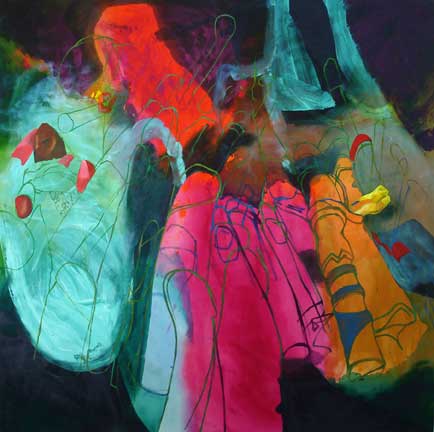Human body interpretations to comprise art exhibit
January 8 to February 8, 2007
 The Body Sublime, a group show that featured artists generating work related to the human body included a wide range of interpretations on the human body: microscopic examinations, full body studies, translucent portrayals, and precision drawings. These works attempt to broaden our conceptions of what is ‘the body’ through alluring visual dialogue. Participating artists include Jennifer Anderson of California; Michael Hopkins, Miriam Martincic, and John Nelson of Illinois; Colleen McCubbin Stepanic, Ohio; and Kathleen Sullivan, Michigan.
The Body Sublime, a group show that featured artists generating work related to the human body included a wide range of interpretations on the human body: microscopic examinations, full body studies, translucent portrayals, and precision drawings. These works attempt to broaden our conceptions of what is ‘the body’ through alluring visual dialogue. Participating artists include Jennifer Anderson of California; Michael Hopkins, Miriam Martincic, and John Nelson of Illinois; Colleen McCubbin Stepanic, Ohio; and Kathleen Sullivan, Michigan.
Anderson uses digital media as a component of her art-making process. “Working in drawing, printmaking, and papermaking, processes that reflect the movement and activity of my body and visceral energies, speaks directly to the content of my art. However, I have recently begun to combine traditional hand-based media with digital processes and outputs. This combination is of increasing appeal to me as it reflects our current societal context and the way computers have become so integrated into our lives, changing our daily activities, languages, and social interactions.”
Hopkins received the prestigious Pollock-Krasner Foundation grant in 2004. Chicago Tribune art critic Alan G. Artner writes about Hopkins previous work on exhibit at the Byron Roche Gallery: “the new white ink drawings are uncanny in their ability to suggest human bone structure as in X-rays before quickly departing to a purer formal realm.” Martincic’s sculptural pieces, carved from stone, reflect an interest in abstraction, distortion, and the beauty of the human body and are informed by her background as a yoga instructor. “It is also about plumbing parts, bottles, and funnels,” she says. “I am working to create abstract figurative forms that reference many objects or body parts simultaneously, and create relationships--often humorous, at least playful--between them. I am interested in the structure of things, in showing how a bent knee is like a plumbing elbow, or how a bent knee is like a bent ankle is like a hip.”
The recent work of Nelson, a painter from Quincy, is comprised of multiple panel groupings. Each panel shows a head that has a different expression and is painted in a particular manner. The story of each grouping is the result of the interaction between the various panels.
Stepanic large-scale 6’ x 6’ paintings are an inquiry into what shapes the human experience. “At the heart of the investigation is structure: its presence and its essence,” she says. “The acrylic paintings were pointedly created without a prefabricated format. The resulting organic and free-flowing works represent a kind of miracle of accident or discovery.”
Participating artist Sullivan, an assistant professor at Hope College in Holland Michigan, was influenced by Roman painters and the Modernist movement. She explains that, while the subject matter is “ostensibly the female figure and the gaze,” the formal language of modernism is also a key component. These paintings were initially based on a series of Roman frescoes from Pompeii’s Villa of the Mysteries, where the narrative of an initiation rite sets ‘realistic’ female figures against a flat space, defined by occasional architectural suggestions.
The musical group Lanterna performed songs from its newly released 5th album, Desert Ocean, as well as previous songs. The group’s new instrumental album leads the listener on a journey through spaces that feel like a drive up and down winding roads, through mountain canyons, and past scenery of beauty and illusion. Lanterna’s previous recordings have been highly praised by Echoes, an NPR nationally syndicated radio program and have received 4 star reviews worldwide.